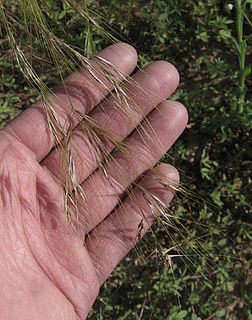
Nassella pulchra, basionym Stipa pulchra, is a species of grass known by the common names purple needlegrass and purple tussockgrass. It is native to the U.S. state of California, where it occurs throughout the coastal hills, valleys, and mountain ranges, as well as the Sacramento Valley and parts of the Sierra Nevada foothills, and Baja California.

Eragrostis hypnoides is a species of grass known by the common name teal lovegrass. It is native to the Americas from Canada to Argentina. It is found in moist areas near water in substrates of sand or mud.
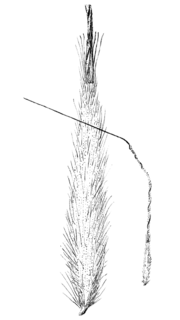
Achnatherum diegoense is a species of grass known by the common name San Diego needlegrass. It is native to southern California, where it is known from San Diego and Ventura Counties and the Channel Islands, and Baja California. It is a resident of chaparral and coastal sage scrub ecosystems below 350 feet in elevation, especially near streams. This is a bunching perennial grass reaching heights between 110 and 140 centimeters. The inflorescence is up to about 25 centimeters long. The hairy spikelet is about a centimeter long not counting the long awn, which can be up to 5 centimeters long and has two distinct kinks.

Achnatherum lettermanii is a species of grass known by the common name Letterman's needlegrass. The updated and accepted name is Stipa lettermanii. It is native to the western United States from California to Montana to New Mexico, where it is a resident of several types of habitat.

Aristida californica is a species of grass known by the common names California threeawn and Mojave threeawn. It is native to the Mojave Deserts and Sonoran of northern Mexico and California and Arizona.
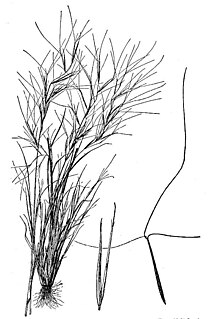
Aristida oligantha is a species of grass known by the common names prairie threeawn and oldfield threeawn.
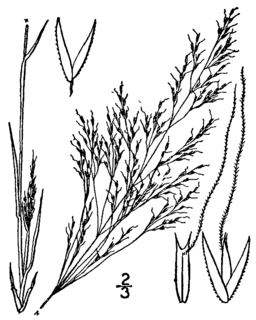
Agrostis elliottiana is a species of grass known by the common name Elliott's bent grass.

Crypsis alopecuroides is a species of grass known by the common name foxtail pricklegrass. It is native to Europe, the Middle East, and North Africa. It is also known in the western United States as a common and widespread introduced species, especially in sandy areas around water, such as lakesides. It has also been collected at shipping points near Philadelphia but has not been seen there in about a century. This is an annual grass producing mostly upright and unbranching stems, often dark in color, up to about 75 centimeters in maximum height. The green leaves are up to 12 centimeters long, sometimes waxy in texture. The inflorescence is a dense cylindrical panicle of tiny green to purple spikelets.

Cynosurus echinatus is a species of grass known by the common names bristly dogstail grass, rough dog's-tail and hedgehog dogtail. It is native to southern Europe, and it is known in the Americas and Australia as an introduced species and sometimes a noxious weed. An herbicide-resistant strain can be found growing as a weed in canola and wheat fields in Chile. This is an annual grass growing 10 to 50 centimeters tall. The inflorescence is a rounded or oval cluster or series of clusters of spikelets. The fertile spikelet has an awn up to a centimeter long. The awns clumped closely together into a tuft gives the inflorescence its bristly, hairy appearance.

Muhlenbergia microsperma is a species of grass known by the common name littleseed muhly. It is native to the Americas from the Southwestern United States and California through Central America into Peru and Venezuela.

Panicum dichotomiflorum, known by the common names fall panicgrass, autumn millet, and fall panicum is a species of Poaceae "true grass". It is native to much of the eastern United States and parts of Canada, and it can be found in the Western United States through California. It may be an introduced species in some western climates. It grows in many types of habitat, including disturbed areas and chaparral habitats.
Panicum urvilleanum is a species of grass known by the common names desert panicgrass and silky panicgrass. It is native to the southwestern United States and northern Mexico, where it grows in sandy habitat, including the dunes of the deserts. It is also known in parts of South America.

Polypogon australis is a species of grass known by the common names Chilean beard grass and Chilean rabbitsfoot grass. It is native to Chile and Argentina. It is also known in parts of the western United States where it is an introduced species and invasive species that grows in moist habitat types such as ditches.

Schismus barbatus is a species of grass known as common Mediterranean grass and kelch-grass. It is native to Eurasia, and it is also known as an introduced species in the southwestern United States. It grows in many habitats, including disturbed areas. It is an annual grass growing in small clumps. The stems grow up to 27 centimeters long and are lined with threadlike leaves. The short inflorescence bears spikelets under a centimeter long.

Setaria pumila is a species of grass known by many common names, including yellow foxtail, yellow bristle-grass, pigeon grass, and cattail grass. It is native to Europe, but it is known throughout the world as a common weed. It grows in lawns, sidewalks, roadsides, cultivated fields, and many other places. This annual grass grows 20 centimeters to well over a meter in height, its mostly hairless stems ranging from green to purple-tinged in color. The leaf blades are hairless on the upper surfaces, twisting, and up to 30 centimeters long. The inflorescence is a stiff, cylindrical bundle of spikelets 2 to 15 centimeters long with short, blunt bristles. The panicle may appear yellow or yellow-tinged.

Setaria verticillata is a species of grass known by the common names hooked bristlegrass, rough bristle-grass and bristly foxtail. It is native to Europe, but it is known on most continents as an introduced species and often a noxious weed. It is a hardy bunchgrass which grows in many types of urban, cultivated, and disturbed habitat. It is a weed of many types of agricultural crops, growing in vineyards and fields. Herbicide-resistant strains have been noted.
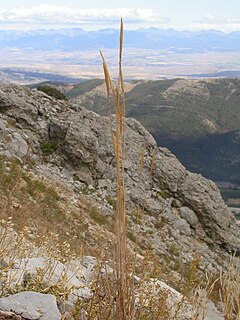
Trisetum spicatum is a species of grass known by the common name spike trisetum and spike false oat. It is native to North America, Eurasia, and South America. In North America it occurs throughout northern regions, including northern sections of the United States and most all of Canada, its range continuing to Greenland. It is widespread throughout the Canadian Arctic Islands. The grass occurs in a variety of Arctic and alpine habitat types, as well as many types of mountainous habitat in regions farther south. It is a perennial grass forming clumps of erect stems ranging in height from just a few centimeters to over one meter. The narrow leaves are mostly located around the bases of the densely clumped stems. The inflorescence is a narrow spike a few centimeters long or up to 30 to 50 centimeters in maximum length. The spikes are green to purple or brownish and shiny.

Ventenata dubia is a species of grass known by the common names North Africa grass and wiregrass. It is native to southern Europe, North Africa and the Middle East. It is becoming well known in North America, where it is an introduced species and a noxious weed of cultivated and disturbed habitat. It is problematic in the Pacific Northwest, where it was first identified in Washington in 1952 and Idaho in 1957. It was found in Utah in 1996. It probably spreads when it gets mixed in with grass seed and is transported and inadvertently planted.

Achnatherum thurberianum is a species of grass known by the common name Thurber's needlegrass. It is native to the western United States, where it occurs from Washington to California and east to Montana and Wyoming.
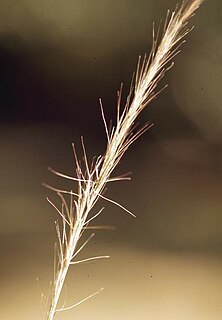
Aristida purpurascens is a species of grass known by the common name arrowfeather threeawn. It is native to eastern North America. One of the three varieties has a distribution extending south into Honduras.



















